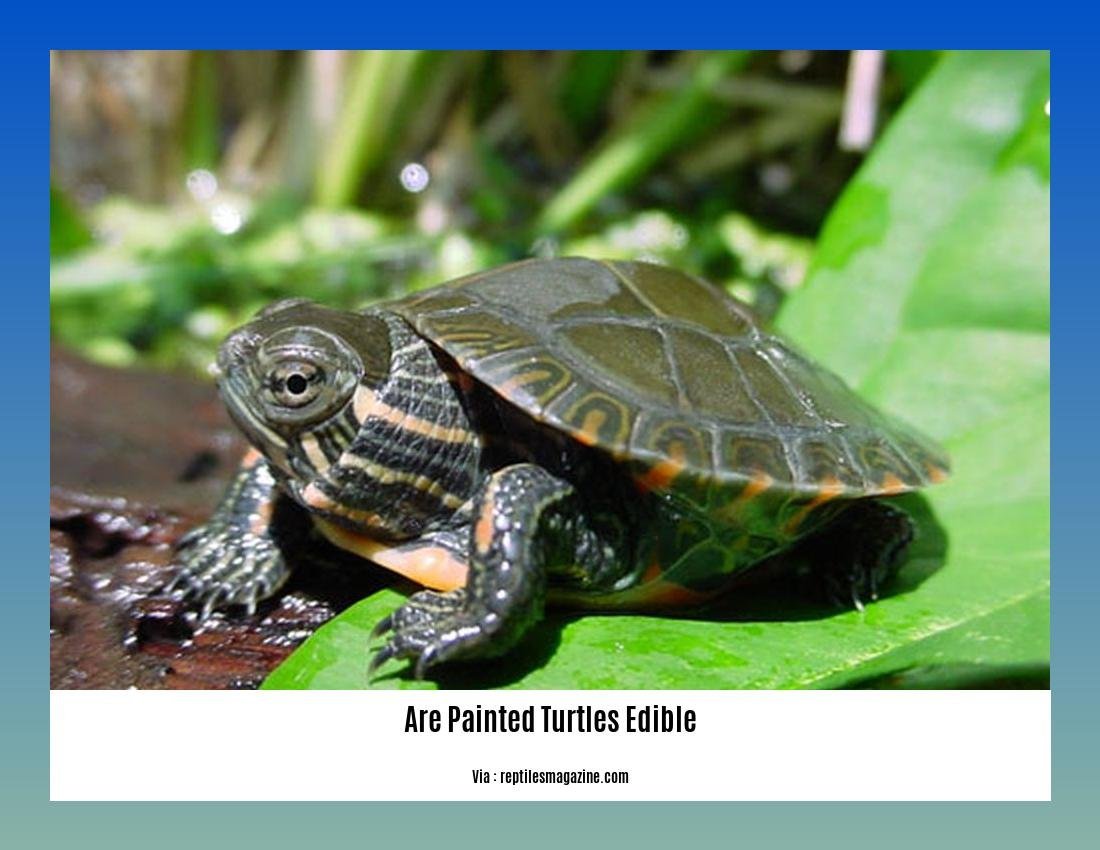Are turtles painted in edible colors? Investigating Painted Turtle Edibility and Cultural Significance
My quest of unusual gastronomic experiences and traditional delicacies has set off many travels into the realm of food. Among these gastronomic adventures, one often asked question is: are painted turtles food? We will explore the edibility and cultural relevance of painted turtles in this post, so clarifying their place in the culinary scene and in different parts of the globe. Come us on this provocative trip as we reveal the mysteries of this less well-known culinary creation.
Key Takeaways:
- Painted Turtles are edible, but certain parts such as the lungs, gall bladder, skeleton, skull, and nails should be avoided.
- It is recommended to remove the tough skin before consuming.
- While Painted Turtles are enjoyed in some parts of the United States, they are not highly regarded as a food source due to their small size and the availability of larger turtle species.
- To learn more about Painted Turtles and their edible qualities, refer to the provided sources.
- When cooking and consuming painted turtle meat, exercise caution and adhere to safe cooking practices.
- Further research or consultation with experts is recommended for information on cooking techniques, storage methods, taste profiles, and where to purchase Painted Turtles.
Are Painted Turtles Edible?

Fascinating animals that not only help to maintain the ecological equilibrium but also have cultural value in many civilizations are painted turtles. But have you ever considered whether these vibrantly colored reptiles are food? The edibility of painted turtles and their function in various cooking customs will be discussed in this page. Thus, let us start straight forwardly.
Paintable Turtles: Their Edibility
With some thought, the answer is yes—painted turtles are edible—that is, except from several factors. Painting turtles have meat that is edible, hence they could be a food source. Still, it’s important to follow sensible cooking guidelines and use care.
One should remove the tough skin of painted turtles before cooking their meat. Since the skin can be really strong, spending time to eliminate it will improve the dining experience. Furthermore avoided for ingestion are several of a painted turtle’s anatomical features: lungs, gall bladder, skeleton, head, and nails.
Culinary Value
Although painted turtles might not be a main food source, their meat is appreciated all throughout the United States. Some areas even see them as a delicacy and have included them into their native cuisine. Paintable turtles are less often eaten than other edible animals, nevertheless, because to their small scale, availability of bigger turtle species, and cultural inclination for other components.
We advise more research to help one better appreciate the cultural relevance of painted turtles and how different cuisines include them. Doing more study or speaking with subject-matter specialists will offer insightful analysis of cooking methods, storage strategies, flavor sensations, and where to find painted turtle meat.
Ultimately, painted turtles are edible, but one should use caution and use proper cooking techniques. An interesting gastronomic experience is advised by eliminating the tough skin and avoiding some anatomical components. Although painted turtles might not be a frequent food source, in some areas they are quite important. Investigating the culinary customs around painted turtle eating offers a rich and distinctive viewpoint on regional food. Thus, if you ever get the chance to sample painted turtle meat, approach it with an open mind and a taste adventurous attitude.
Remember, discovering less well-known edible species like painted turtles helps us to widen our gastronomic horizons and value the many flavors and customs discovered worldwide. Happy cooking and exploring!
Here are some interesting topics related to animals that you might want to explore further:
- Are elephants nice to humans? Find out more about the behavior of these majestic creatures here.
- Have you ever wondered if elephants are sacred in India? Discover the cultural significance of elephants in India here.
- Are loggerhead turtles dangerous? Dive into the world of these fascinating marine animals here.
Explore these topics and satisfy your curiosity!
The Nutritional Value of Painted Turtles
Renowned for their vivid shells and distinctive markings, painted turtles have long fascinated foodies as well as environmentalists. For individuals who want to investigate many gastronomic sensations, these omnivorous animals are a fascinating topic since they have a varied diet including plants and animals. But exactly, what nutritional worth painted turtles offer? Let’s delve in and learn.
Painted turtles consume what?
Painted turtles in the wild eat insects, tiny fish, crustaceans, tadpoles, and aquatic plants among other things. Animal and plant stuff taken together gives them a wide spectrum of nutrients. To guarantee they get the required nutrients, painted turtles kept in captivity can be given a similar diet including insects, fish, and plant matter.
A Balanced Meal
Providing painted turtles with a well-balanced diet including both plant and animal matter is advised to help them to stay in best health. Most vegetables have vital elements like calcium and phosphorous, which help to preserve the bone condition of turtles. Offering a range of veggies, like leafy greens, carrots, and squash, you can guarantee their dietary needs are satisfied.
Giving Hatchlings Food
Turtle pellets can be included into the diet of infant painted turtles together with a range of vegetables and herbs. These pellets are designed especially to supply the vital nutrients required for their development and expansion. Introducing a variety of meals helps educate their taste buds and guarantees they have a balanced diet from a young age.
Exercise Care and Steer Clear of Harmful Foods
Although painted turtles can provide nutrients, it’s important to use caution and follow good cooking techniques. Before eating painted turtle flesh, ensure sure the tough skin is removed. Furthermore stay away from some anatomical sections including the lungs, gall bladder, skeleton, skull, and nails. These components might be dangerous for your health or taste strongly enough for some people not like.
Painted turtles are not as often devoured as other edible animals, thus they are not particularly valuable. Their low consumption is influenced by elements including their small size, the availability of bigger turtle species, and cultural tastes. For individuals who are eager to investigate less-known food species, though, adding painted turtles to their menu will open their horizons and inspire respect of many tastes and customs.
Key Takeaways:
- Painted turtles are omnivorous, consuming both plants and animals.
- In the wild, their diet consists of insects, small fish, crustaceans, tadpoles, and aquatic plants.
- In captivity, painted turtles can be fed a variety of foods such as insects, fish, and plant material.
- It is important to provide a balanced diet that includes both plant and animal matter for their optimal nutrition.
- Avoid feeding painted turtles foods that are toxic to them, such as avocado, rhubarb, and chocolate.
- Turtle pellets can be given to baby painted turtles along with a variety of vegetables and plants.
- Exercise caution and safe cooking practices if considering consuming painted turtle meat, removing the tough skin and avoiding certain anatomical parts.
- Painted turtles are not widely consumed compared to other edible creatures due to their small size, availability of larger turtle species, and cultural preferences.
- Exploring lesser-known edible creatures can expand culinary horizons and foster an appreciation for diverse flavors and traditions.
Sources:
– The Best Food for Painted Turtles: A Comprehensive Guide
– What Vegetables Can Painted Turtles Eat? (Including List)
Methods of Preparing and Cooking Painted Turtles

Understanding the Diet of Painted Turtles
Knowing the Painted Turtle Diet
It’s important to know painted turtles’ natural diet before we examine their gastronomic features. Painted turtles are omnivores in the wild, eating a range of aquatic vegetation, tiny fish, crustaceans, and insects. Their growth and development require certain nutrients, which this varied diet supplies.
Regarding maintaining painted turtles in captivity, their diet can be augmented with other items. Included are vegetables including lettuce, spinach, kale, and diced apples and bananas. Turtles cannot, however, efficiently break down all the nutrients in fruits and vegetables. These should so be only consumed in moderation.
Techniques for Creating Painted Turtles
If you are thinking of getting painted turtles ready for a gastronomic excursion, you need use careful cooking techniques. Here are some main techniques for getting painted turtles ready for eating:
One removes tough skin.
One must first remove the tough skin of painted turtle flesh before cooking it. Given its rather leathery texture, chewing and digesting the skin can be difficult. Careful skin removal will help the meat’s texture to be improved generally.
2. Internal Temperatures and Safe Food Handling
To prevent foodborne diseases, painted turtle flesh should be handled carefully, much as with any other meat. During cooking and preparation, guarantee correct hygienic habits. To further eradicate any possible bacteria, the meat should also be cooked to at least 165°F (74°C).
3. Suggested Cooking Techniques
There are several techniques one can apply in cooking painted turtle flesh. Among the popular cooking methods are grilling, baking, boiling, or perhaps including the meat into stews or soups. These techniques guarantee the meat is safely cooked and let you play with tastes and textures.
Cultural Value and Considerations
Although painted turtles are food, their consumption is not as great as that of other edible animals. Their little scale and regional cultural preferences help to explain this. Investigating gastronomic experiences calls for appreciation of cultural variety and ethical considerations.
More study is advised to help one better appreciate the cultural value of painted turtles and their inclusion into different cuisines. Appreciating the varied tastes and customs around less well-known food animals helps us widen our gastronomic horizons.
Key Takeaways:
- Painted turtles are edible, and their meat can be prepared and cooked using various methods.
- Before cooking, it is advisable to remove the tough skin of the painted turtle.
- Safe food handling practices and cooking the meat to a minimum internal temperature of 165°F (74°C) are essential.
- Popular cooking methods for painted turtle meat include grilling, baking, boiling, and incorporating it into soups or stews.
- Cultural preferences and the availability of larger turtle species contribute to the limited consumption of painted turtles.
- Exploring lesser-known edible creatures like painted turtles exposes us to new flavors and traditions while promoting cultural appreciation.
Sources:
– The Best Food for Painted Turtles: A Comprehensive Guide
– What Vegetables Can Painted Turtles Eat? (Including List)
Controversies and Ethical Considerations Surrounding the Consumption of Painted Turtles
Key Takeaways:
- The consumption of painted turtles raises controversies and ethical considerations due to their cultural significance and ecological role.
- Harvesting painted turtles for consumption can have a negative impact on their populations and disrupt the balance of ecosystems.
- Some communities and conservation organizations advocate for the protection and conservation of painted turtles to preserve their natural habitats and populations.
- The traditional and cultural significance of painted turtles may vary across different regions, and understanding these perspectives is crucial when discussing their consumption.
- Ethical considerations surrounding the consumption of painted turtles include concerns about sustainability, animal welfare, and the potential spread of diseases.
Using painted turtles for consumption generates moral questions and debates. The cultural value of painted turtles and their part in ecosystems generate these conflicts. Although certain areas regard them as a delicacy and they are edible, it is important to take into account the possible effects on their numbers and the ecosystems they occupy.
Crucially vital for the ecology, painted turtles help to balance aquatic environments. Many times seen as indicator species, their existence or absence offers information on the condition of their environments. Harvesting painted turtles for food can upset their numbers, resulting in ecological imbalances and perhaps extinction of this species.
Certain towns and some conservation groups support painted turtle protection and preservation. They underline the need of maintaining their natural environments and guaranteeing the population survival. Protecting painted turtles helps us to preserve the ecological integrity of aquatic environments and safeguard the diversity within them.
When debating painted turtle consumption, one must take cultural and traditional value associated to them into great account. Various areas might see painted turtles’ edible character from different angles. Investigating these cultural settings helps one to have a better knowledge of the interaction between people and painted turtles.
Consumption of painted turtles is significantly influenced by ethical issues. A major issue is sustainability since overharvesting could cause population drop and risk species existence. Animal welfare is another ethical issue since painted turtle collection, treatment, and slaughter have to be conducted compassionately.
Moreover, eating wild-caught painted turtles raises questions regarding the possible disease dissemination. Natural environment pathogens and parasites could endanger human health if appropriate cleaning and cooking methods are neglected. While cooking and eating painted turtles, food safety and hygiene should first take front stage.
Finally, the eating of painted turtles generates moral questions and disputes. When debating the edibility and ethical issues surrounding painted turtles, preservation of their numbers, preservation of ecological balance, respect of cultural viewpoints, and food safety become absolutely vital issues.
Citation:
- PawTracks: These Are the Yes and No Foods for Painted Turtles
- TurtleOwner.com: What Do Painted Turtles Eat?
FAQ
Q1: Eatable painted turtles?
With exception of the lungs, gall bladder, skeleton, skull, and nails, painted turtles are indeed edible. For a better dining experience, it is advised to remove the tough skin before eating though.
Q2: Why are painted turtles not especially sought for food?
A2: Given their tiny scale and the availability of bigger turtle species, painted turtles are not particularly sought for food. Although their meat is consumed all throughout the United States, its size and the presence of more sizable turtle species make them less sought for.
Q3: Taste of painted turtles?
A3: Cooking technique and seasonings employed will affect the flavor of painted turtle flesh. Their taste range is described as mild, somewhat earthy, or as meat that reminds one of chicken or frog legs.
Q4: Paint turtle cooking techniques?
A4: Paintable turtles can be cooked using boiling, baking, grilling, or sautéing among other techniques. To reduce any possible health hazards, the turtle should be cooked fully.
Q5: Where might I get painted turtles for consumption?
A5: It is noteworthy that in some areas painted turtle sales and consumption could be controlled or prohibited. Should you choose to buy painted turtles for consumption, it is advised to review local laws and rules on turtle sales and consumption.
q
















